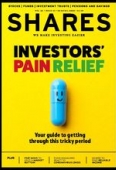Archived article
Please note that tax, investment, pension and ISA rules can change and the information and any views contained in this article may now be inaccurate.
Everything you need to know about investment funds

In the latest part of our first-time investor series, we explain the benefits of investing in funds, investment trusts and exchange-traded funds (ETFs).
There are thousands of funds on offer which provide access to an array of asset classes, geographic regions and investment styles ranging from growth and value to income.
This diverse universe of products is the best starting place for someone new to investing rather than individual company shares. That’s because nearly all of them give you instant diversification.
Rather than buying one or two company shares yourself, a fund will give you access to a basket of many different companies – typically between 20 and 200 – and sometimes even other assets like property, bonds and commodities.
INV VS ACC
When purchasing investment funds, you’ll often notice the use of the acronyms ‘inc’ or ‘acc’ after the name, which denote the different classes of funds.
An ‘inc’ or ‘income’ class pays out dividends directly into your investment account as cash, whereas an ‘acc’ or ‘accumulation’ class rolls up dividends and other forms of income and puts them back into the fund, with the effect of increasing the value of each unit or share held.
If something goes wrong with an individual company share you’ll feel the pain in your portfolio. But if something went wrong with one of the companies in a fund’s portfolio, it will have lots of other companies hopefully doing well to help cushion the blow.
ACTIVE VS PASSIVE FUNDS
Investors can purchase two main types of funds – active and passive. Active funds are run by a professional fund manager who selects the investments and aims to beat a benchmark index or outperform the broader stock market.
We all lead busy lives, so the ability to delegate the day-to-day running of your money to a professional fund manager, paid to ensure your wealth pot grows, is a major attraction.
High-profile examples of active funds include global large cap fund Fundsmith Equity (B41YBW7), managed by veteran investor Terry Smith; Fidelity Special Situations (B88V3X4), steered by value contrarian Alex Wright; and in the fixed income universe, the Ariel Bezalel-led Jupiter Strategic Bond (B4T6SD5).
Passive or ‘tracker’ funds differ from active funds in that they mirror or track the performance of a benchmark or index such as the S&P 500 or FTSE 100. These typically have lower charges than active funds and are growing in popularity as investors seek the lowest cost option for their investments.
FUNDS VS INVESTMENT TRUSTS
The term investment fund is generally used to describe unit trusts and Oeics, which include the aforementioned Fundsmith, Fidelity and Jupiter funds.
A fund will create new units when someone invests money or it will cancel units when someone withdraws their cash, hence the term ‘open-ended fund’.
Managers who run these funds have to deal with inflows and outflows of investor money, as well as deciding what to have in the portfolio.
In comparison, investment trusts fall under the category of ‘closed-end fund’. They have a fixed number of shares in issue and investors wanting to get involved have to buy shares from another investor.
When an investor wants to get out, they sell their shares to someone else. This exchange means the fund manager doesn’t have to manage any inflows and outflows of money and they can concentrate purely on running the portfolio.
The first trust, F&C Investment Trust (FCIT), formerly Foreign & Colonial, was launched in 1868. Other well-known trusts include Alliance Trust (ATST), Baillie Gifford-managed Scottish Mortgage (SMT) and Finsbury Growth & Income (FGT).
KEY POINTS TO CONSIDER
The price of an open-ended fund will match the value of the underlying assets. It’s different with investment trusts where the price is dictated by supply and demand. This means their shares can trade at a discount or a premium to the net asset value (NAV) of the underlying portfolio.
While buying an investment trust at a discount is typically regarded as bagging a bargain, there are often reasons why a trust languishes on a discount which may give you pause for thought.
Trusts trading at a premium to NAV aren’t that common. Where they do swap hands for more than the underlying NAV, this usually reflects strong investor demand to access the skills of the manager, the strategy or the asset class in question.
Another key difference between trusts and funds is the former’s ability to borrow money for additional investment. This is known as ‘gearing’; there are strict limits on how much gearing an investment trust can employ.
Gearing can magnify returns when markets rise, assuming the trust earns a return on borrowed money that is higher than the interest it pays on its loan. When markets fall, you can expect the shares of a geared trust to fall further than an ungeared trust.
KEY POINTS ABOUT ETFS
Exchange-traded funds are growing in popularity as a simple, low-cost tool for getting access to a range of companies, commodities and countries. They are similar to funds in that they invest in a pool of assets and provide exposure to a particular theme or market.
Like investment trusts (but not like investment funds), ETFs trade on a stock exchange and you can buy or sell them at any time during trading hours at the price shown (with the price changing in accordance to demand). Investment funds are only priced once a day.
ETFs are fairly transparent. Unlike a fund or investment trust, whose manager might be reluctant to reveal their holdings and tactics, you can generally see what ETFs are investing in because the vast majority track a specific index, such as the FTSE 100 or S&P 500.
They will clearly state the name of each index, so you can easily check how that index is constructed via a quick search on the internet.
In recent years, ETFs have become increasingly popular with retail investors, in part due to their low costs but also because of the fact many active fund managers fail to beat their benchmarks. This is despite charging higher fees which eat into investor returns.
WHICH ACCOUNT SHOULD I USE?
All types of funds can be held in ISAs, SIPPs and dealing accounts.
You might want to start with an ISA as all investments inside this wrapper are shielded from the taxman, so you don’t pay tax on capital gains or income. You can also take your money out when you like, although Lifetime ISAs have some tricky rules on withdrawals depending on the circumstance – more information here.
Consider using a SIPP, which is a pension wrapper, if you’re happy to lock up your money until at least age 55 and want to benefit from the Government topping up your contributions via tax relief.
Dealing accounts should really only be considered if you’ve used up all your ISA allowance in a tax year and don’t want to put that money into a SIPP.
POTENTIAL PLACES TO START
If you are new to investing, you might want to look at an ETF which tracks a basket of shares in different parts of the world.
For broad brush exposure to growth stocks listed across the pond for example, relevant ETFs include iShares Core S&P 500 ETF (0JFF) which tracks the performance of the US S&P 500 index whose constituents include Apple and Coca-Cola.
The likes of iShares Core FTSE 100 ETF (ISFU) provide passive exposure to the 100 largest listed companies in London such as Unilever (ULVR) and HSBC (HSBA).
ETFs tracking companies around the world include Lyxor Core MSCI World ETF (LCWL) which mirrors the performance of the MSCI World, an index of more than 1,600 stocks trading in 23 different developed market countries. Among the names in the index are Microsoft, Johnson & Johnson and Nestle.
Important information:
These articles are provided by Shares magazine which is published by AJ Bell Media, a part of AJ Bell. Shares is not written by AJ Bell.
Shares is provided for your general information and use and is not a personal recommendation to invest. It is not intended to be relied upon by you in making or not making any investment decisions. The investments referred to in these articles will not be suitable for all investors. If in doubt please seek appropriate independent financial advice.
Investors acting on the information in these articles do so at their own risk and AJ Bell Media and its staff do not accept liability for losses suffered by investors as a result of their investment decisions.
Issue contents
Feature
First-time Investor
Great Ideas
Investment Trusts
News
- Market mood lifted by huge financial support but investors remain wary
- Why oil prices have plunged to 18-year lows
- Housing market goes into coronavirus hibernation
- Bill Ackman sets record straight after $2.6bn win
- Temple Bar dumps holdings after share price collapse
- Byotrol steps up in the fight against coronavirus
- Have capital preservation funds lived up to their name?

 magazine
magazine











